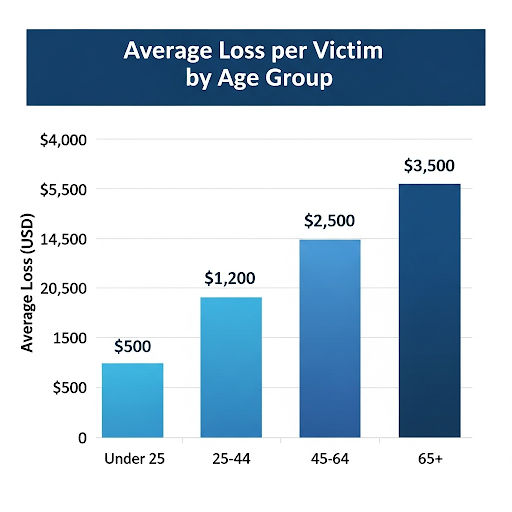The Price of a Click: How Cyberattacks Hit Older Adults Harder
Cybercrime hits everyone, but it takes a heavier financial toll on older adults -seniors lose more money per incident than younger age groups.
Miki
9/16/20253 min read


Case Study: Margaret’s Story
Margaret, 74, thought she was helping her grandson in an emergency.
A caller — whose voice sounded just like him — said he was in trouble and needed money wired immediately. She sent $3,200 before realizing it was a scam.
Why it worked: The scammer used publicly available info from social media and AI voice-cloning technology.
The fallout: Beyond the money, Margaret’s trust in her own judgment took a hit.
Younger Victims Aren’t Immune
While older adults lose more money per incident, younger people are scammed more often.
Under-25s are more likely to fall for phishing links in DMs or get tricked by fake job offers.
Many don’t report the loss, assuming “it’s only $50” — but those small amounts add up across millions of cases.
How Intergenerational Mentoring Changes the Story
Our non-profit’s approach pairs tech-savvy youth with older adults for ongoing digital mentoring.
This does more than teach “how to use a phone” — it builds awareness, prevention habits, and trust.
For Older Adults:
Learn to spot red flags like suspicious URLs, odd grammar, and urgent requests for gift cards or wire transfers.
Practice verifying calls before sending money.
Use two-factor authentication to protect financial accounts.
For Youth Mentors:
Recognize their own risk — scams targeting job seekers, gamers, and social media users.
Learn leadership and communication skills.
Build empathy for challenges older adults face online.
The Economic Ripple Effect
Cybercrime is not just a personal tragedy — it’s a community-wide economic drain.
Every dollar stolen from an older adult often means less spending in the local economy.
Family members may need to step in financially, straining their own budgets.
Rebuilding after identity theft can take months or even years.
A Shared Firewall
We think of our program as creating a human firewall:
Layer 1: Awareness — know the scam tactics before they reach you.
Layer 2: Support — have a trusted person to check with before acting.
Layer 3: Skills — know how to secure devices, accounts, and personal info.
From Vulnerable to Vigilant
In our last 6-month program cycle:
Older adult scam reports dropped by 38% among participants.
Youth mentors reported 45% more awareness of phishing attempts in their own lives.
We saw a 26% increase in older adults using secure password managers.
The Call to Action
If we can close the tech-knowledge gap and the cybersecurity gap between generations, we can cut these numbers drastically.
That means:
Schools incorporating cyber safety volunteer programs.
Senior centers partnering with youth organizations.
Funding programs that train both sides — because everyone benefits.
In Margaret’s Words
“I used to think scams only happened to people who weren’t careful. Now I know they can happen to anyone — but I also know I have tools to protect myself.”
Conclusion
Cybercrime costs are rising, but we can fight back by connecting generations.
When we pair youthful energy with life experience, we not only protect wallets — we protect dignity, independence, and community trust.
The Hidden Cost of Cybercrime
Cyberattacks don’t just steal data — they steal peace of mind, independence, and sometimes entire life savings.
And while cybercriminals don’t discriminate, their scams often hit certain groups harder. The numbers tell a clear story: the older you are, the bigger the financial hit when a scam succeeds.
The Data
We compiled loss statistics based on Federal Trade Commission (FTC) consumer reports and cybersecurity research, showing the average loss per victim by age group.
Why Older Adults Lose More
Higher-value targets – Older adults often have more savings, retirement accounts, and valuable assets that criminals know about.
More trusting behavior – Many scams rely on building a false sense of urgency or trust; older adults may be more likely to believe an “official” call or email.
Less familiarity with modern scams – Newer fraud tactics like deepfake voice calls or cryptocurrency investment scams are unfamiliar and confusing.
The Human Side of the Numbers
Let’s put this in perspective:
For a 20-year-old, losing $500 might mean replacing a stolen phone.
For a 70-year-old, losing $3,500 could mean skipping rent, delaying a medical procedure, or losing a big chunk of retirement funds.

